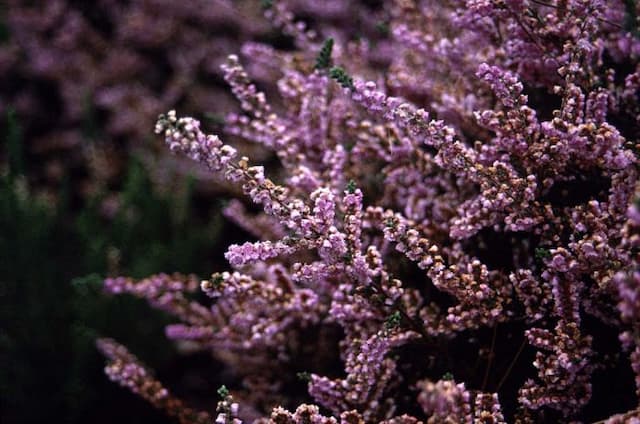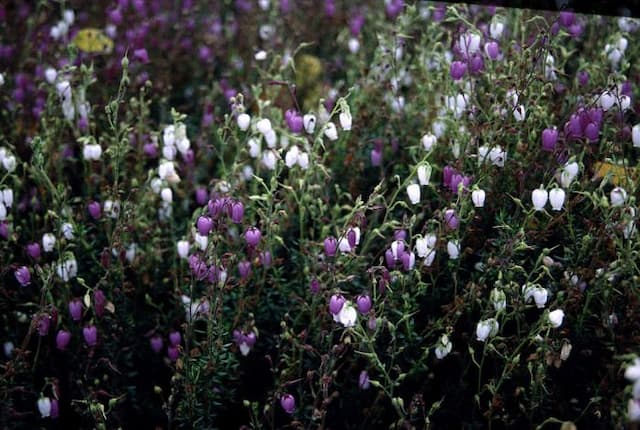Redvein Enkianthus Enkianthus campanulatus

ABOUT
The plant commonly known as redvein enkianthus displays an elegant and structured appearance with its upright, branching habit. Its leaves are simple, ovate to oblong in shape with serrated edges, and they are arranged alternately along the stems. The leaves are notable for their attractive green color which can turn into a vibrant red, orange, or yellow during the fall, offering a striking autumnal display. This deciduous shrub blooms in spring, bearing clusters of small, bell-shaped flowers. Each flower has a creamy white to pale pink color with distinctive red veins that create a delightful contrast, and hence the common name redvein enkianthus. The flowers hang elegantly from the branches, adding a layer of visual interest to the plant's profile. Beyond its colorful foliage and charming flowers, the plant has a rugged, exfoliating bark that provides winter interest. Once the leaves have fallen, the bark peels away in strips to reveal layers of color—adding texture and depth to the winter landscape. Overall, the redvein enkianthus is admired for its layered beauty and seasonal transformations that add a dynamic quality to gardens where it is grown.
About this plant
 Names
NamesFamily
Ericaceae.
Synonyms
Redvein Enkianthus, Redvein Enkianthus, Furin-Tsutsuji.
Common names
Enkianthus campanulatus.
 Toxicity
ToxicityTo humans
The plant known as Redvein Enkianthus is not commonly regarded as toxic to humans. There is limited information on its toxicity, and it is generally not associated with poisoning upon ingestion. However, as with any plant, individual allergies or sensitivities can occur, and it is always advisable to avoid ingesting parts of ornamental plants due to potential unpredictable effects.
To pets
Redvein Enkianthus is not commonly known to be toxic to pets. There is a scarcity of information suggesting any significant toxicity to dogs, cats, or other household animals. However, it's always prudent to prevent pets from ingesting plants, as they could potentially cause gastrointestinal upset or an allergic reaction in certain sensitive animals.
 Characteristics
CharacteristicsLife cycle
Perennials
Foliage type
Deciduous
Color of leaves
Green
Flower color
Pink
Height
6-10 feet (1.8-3 meters)
Spread
4-6 feet (1.2-1.8 meters)
Plant type
Shrub
Hardiness zones
5
Native area
Japan
Benefits
 General Benefits
General Benefits- Ornamental value: Enkianthus campanulatus, commonly known as redvein enkianthus, is valued for its bell-shaped flowers and vivid fall color, making it a popular choice for garden landscapes.
- Habitat for Wildlife: The plant provides nectar for pollinators like bees and butterflies, thereby supporting local ecosystems.
- Drought Resistance: Once established, it has good drought tolerance, making it suitable for gardens in areas with water scarcity.
- Shade Tolerance: Redvein enkianthus can thrive in partial shade, giving gardeners more planting options in spots that receive less sunlight.
- Cold Hardiness: It is capable of surviving in colder climates, which makes it a sturdy addition to gardens in zones 5 through 8.
- Low Maintenance: The plant requires minimal upkeep once it is established, making it a convenient choice for both novice and experienced gardeners.
- Non-Invasive: As a non-invasive species, it does not threaten local flora, ensuring ecological balance when planted in gardens or natural settings.
 Medical Properties
Medical Properties- This plant is not used for medical purposes.
 Air-purifying Qualities
Air-purifying QualitiesThis plant is not specifically known for air purifying qualities.
 Other Uses
Other Uses- Enkianthus campanulatus, commonly known as redvein enkianthus, can be used as a natural dye, with various parts like leaves and bark providing subtle colorings for fabrics.
- As an acid-loving plant, redvein enkianthus can serve as an indicator of soil pH, thriving in conditions that might be less suitable for other plant species.
- The plant's strong root system makes it useful for erosion control on slopes or in areas prone to soil degradation.
- Redvein enkianthus wood is sometimes used in fine woodworking for crafting small objects or inlays that require hard, dense wood with a fine grain.
- During the fall, the plant is sought after for its vibrant autumn leaf colors and can be used in landscaping to contribute to seasonal garden displays.
- Its bell-shaped flowers can be a source of nectar for bees and other pollinators, playing a role in supporting local ecosystems.
- In Japan, the plant is often used in traditional Niwaki gardening to create sculpted shapes and forms that align with the principles of Zen aesthetics.
- The plant's resistance to deer browsing makes it an ideal choice for gardens in areas with high deer populations, minimizing the need for additional protective measures.
- Redvein enkianthus can be used in bonsai culture, where its attractive flowers and foliage, along with its adaptability to pruning, make it a suitable candidate for miniature landscapes.
- Its upright branching structure provides winter interest in gardens, as the arching branches create a striking silhouette against the snow.
Interesting Facts
 Feng Shui
Feng ShuiThe Redvein Enkianthus is not used in Feng Shui practice.
 Zodiac Sign Compitability
Zodiac Sign CompitabilityThe Redvein Enkianthus is not used in astrology practice.
 Plant Symbolism
Plant Symbolism- Refinement: Enkianthus campanulatus, commonly known as redvein enkianthus, with its delicate bell-shaped flowers and elegant structure, is often associated with sophistication and graceful beauty.
- Transition and Change: As a plant that goes through a vibrant transformation in color during autumn, redvein enkianthus can symbolize life's transitions and the beauty found within change.
- New Beginnings: The blooming of redvein enkianthus flowers can represent starting anew or embarking on a fresh phase in life, just as the plant blossoms with the coming of spring.
- Endurance: Native to Japan, this plant is known to endure cold climates and is often a symbol of the ability to withstand challenges and emerge stronger.
 Water
WaterFor the Redvein Enkianthus, maintain consistent moisture by watering deeply once a week, providing about a gallon of water each time for a medium-sized shrub. During hot and dry periods, increase watering frequency to twice a week. It's important not to overwater, as the plant does not tolerate soggy soil; ensure good drainage. During winter months, reduce watering since the plant’s water requirements decrease. Always check the top few inches of soil for dryness before watering again.
 Light
LightThe Redvein Enkianthus thrives best in partial shade to full sun conditions. Preferably, plant it in a spot where it can receive morning sunlight and some afternoon shade to protect it from the intense heat of the day. An eastern or northern facing location that receives dappled sunlight throughout the day is ideal for optimal growth.
 Temperature
TemperatureRedvein Enkianthus is hardy and can survive in temperatures as low as 0°F and as high as 90°F. However, the ideal temperature for this plant is between 60°F and 75°F. It's advisable to plant it in a location that is protected from harsh winter winds to prevent cold damage.
 Pruning
PruningPrune the Redvein Enkianthus in late winter or early spring before new growth starts. This helps to maintain the plant’s shape, remove any dead or broken branches, and encourage healthier, more vigorous growth. Pruning every year or two is typically sufficient, ensuring cuts are made just above a healthy set of leaves or buds. The best time for pruning is during dormancy to minimize stress on the plant.
 Cleaning
CleaningAs needed
 Soil
SoilRedvein Enkianthus thrives in acidic soil with a pH of 4.5 to 6. A mix of peat, pine bark, and coarse sand encourages good drainage and aeration. Incorporate organic matter like compost to enrich the soil and maintain the necessary acidity.
 Repotting
RepottingRedvein Enkianthus should be repotted every 3-5 years. Younger plants may need repotting more frequently, while established plants can be left longer if they are not root-bound.
 Humidity & Misting
Humidity & MistingRedvein Enkianthus prefers moderate humidity levels. Indoor environments should aim to maintain around 40-60% relative humidity for optimal growth.
 Suitable locations
Suitable locationsIndoor
Place in bright, indirect light and maintain acidic soil.
Outdoor
Plant in partial shade with moist, acidic soil.
Hardiness zone
5-8 USDA
 Life cycle
Life cycleRedvein enkianthus (Enkianthus campanulatus) begins its life as a seed, which upon germination in favorable conditions grows into a small seedling. The seedling then develops into a juvenile plant, establishing a root system and beginning to form its characteristic leaves. As it matures, the plant enters the vegetative stage, during which it experiences significant growth and may become a shrub or small tree, depending on environmental factors. It reaches reproductive maturity and enters the flowering stage, typically producing bell-shaped, cream to pink flowers often veined with red in late spring to early summer. Following pollination, usually by insects, the plant sets fruit, which are small capsules containing numerous seeds. The life cycle can begin anew when these seeds are dispersed, often by wind or gravity, and find suitable conditions to germinate.
 Propogation
PropogationPropogation time
Late winter-early spring
The most popular method for propagating the Redvein Enkianthus (Enkianthus campanulatus) is by seed. Ideally, sowing takes place in late winter to early spring. The seeds are fine and should be sown on the surface of a well-drained, seed-starting mix, as they require light for germination. It's important to keep the soil consistently moist but not waterlogged. Once sown, the container can be covered with a clear lid or plastic wrap to maintain humidity. Germination can be sporadic, often taking several weeks to months, and seedlings should be grown under protection for their first winter before being planted out in their permanent positions in the following spring or autumn.









